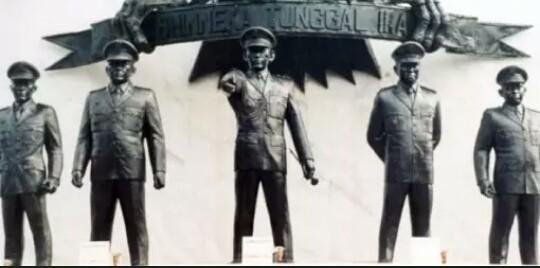Actually There are 8 Generals to Be Kidnapped During G30S / PKI

During the last meeting of the abduction of the General Council at Sjam Kamaruzzaman's house, in Salemba Tengah, on H-Day, 30 September 1965, it was precisely the name of the eight generals to be picked up.
They were General AH Nasution, Lt. Gen. Ahmad Yani, Major General Soewondo Parman, Major General R. Soeprapto, Major General Mas Tirtodarmo Harjono, Brigadier General Donald Izacus Pandjaitan, Brigadier Soetojo Siswomihardjo and Brigadier General Ahmad Soekendro.
Who was Brigadier General Ahmad Sukendro and why did he survive the abduction?
Achmad Sukendro was born in Banyumas in 1923.
Like many young people his age, in Japanese times, he chose to register as a member of PETA.
During the revolution, Sukendro joined the Siliwangi Division. Nasution who 'found him' soon knew he was not an ordinary officer.
Sukendro's thinking and analytical skills above the average of other officers.
Therefore, when Nasution became KSAD, he appealed Sukendro as Asintel I KSAD. In fact, Sukendro did not disappoint.
In 1957, when local officers fretted at Jakarta's policy and intend to demand an autonomous option, Sukendro - certainly on Nasution's behest - staged an intelligence operation.
His men entered the area and infiltrated the mindsets of the officers in the area.
The result, when the atmosphere peaked, practically only the commander in Sumatra (PRRI) and Sulut (Permesta) who declared themselves separated from Indonesia.
Others, withdraw their support and remain in the flutter of Red and White.
Not only in the national scope alone gait Sukendro. Along with the learning tasks he acquired in the United States (US), he also successfully established contact with the CIA.
Several TNI and CIA cooperation programs, stop by his hands.
To the extent that there is an assumption at that time, Sukendro figure is the main link that connects Nasution and Achmad Yani with the CIA.
Even in one version of the Gestok scenario, due to his intelligence and his good lobby with the CIA, Sukendro is mentioned as one of the suspected masterminds, as mentioned in the book Revealing the Mystery of FX's Soeharto Powers. Baskara Tulus Wardaya
If on the one hand is considered a dalang, what other side makes Sukendro included in the list of PKI shooting?
Sukendro is an important figure in the military. His name belongs to an elite general group close to Nasution and Yani.
Later the group was known as the Council of Generals. Its members are 25 people, but four are Maj. Gen. S Parman, Major General MT Haryono, Brigadier General Sutoyo Siswomihardjo, and Brigjen Sukendro himself.
The group is actively doing a political counter to counter the PKI's dominance. Well, Sukendro's pokal certainly made the PKI growled.
For the PKI, this one intellectual officer was a latent danger.
Unfortunately, Soekarno asked Sukendro to become a member of the Indonesian delegation to commemorate the Birthday of the Republic of China, October 1, 1965. Congratulations him from the abduction victim.
After the incident, Sukendro's role began to be marginalized by Ali Moertopo's gait.
He could not stem Ali's intelligence webs which accelerated Soekarno's collapse.
However, at least, Sukendro is still trying to work. The so-called former Cuban ambassador and Soekarno's close friend, AM Hanafi, in his biography showed it.
On March 11, 1966, when the President was followed by wartaks rushed to Bogor for fear of the Kemal Idris Force, Sukendro advised AM Hanafi to chase the president and stick it wherever he was.
"Do not leave me alone," said Sukendro. It seems that Suekndro's intelligence instinct is still sharp enough to read the direction of the times.
Unfortunately, AM Hanafi can only regret for not getting the helicopter that day.
That afternoon also Suharto's envoy succeeded in obtaining a letter of surrender of power (Supersemar).
When Soeharto rose to the top of power, the Sukendro star was practically dim. However, although drowned he did not necessarily fell silent.
In an officers' course in Bandung, he surprisingly acknowledged the existence of the Council